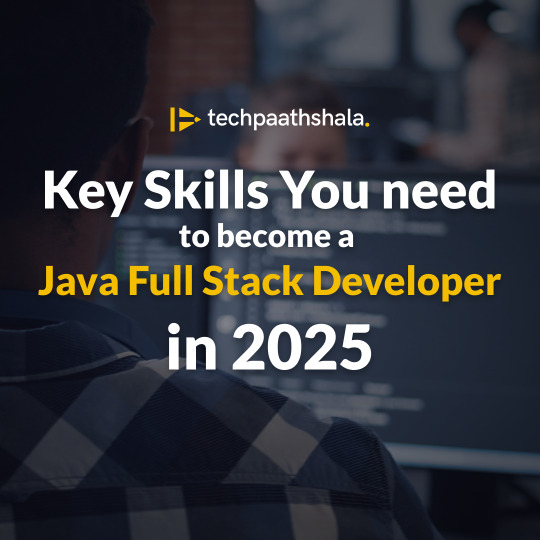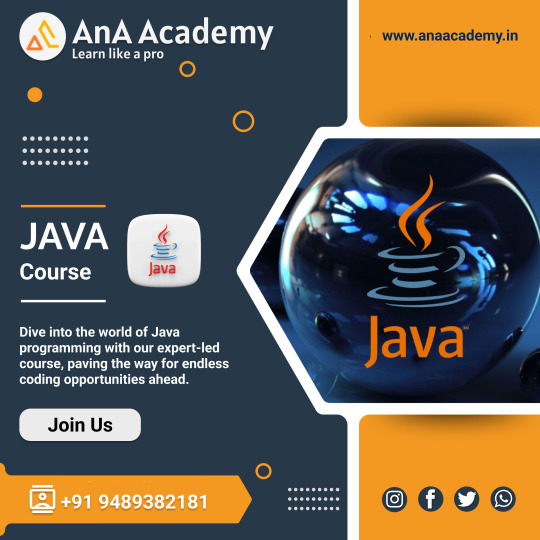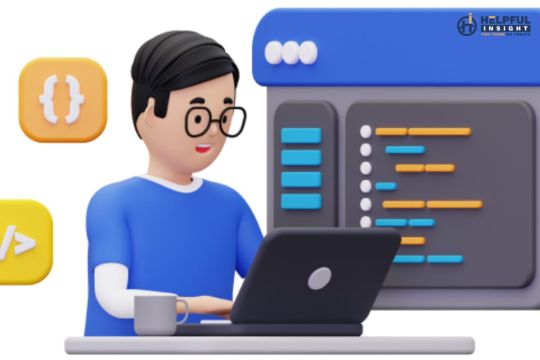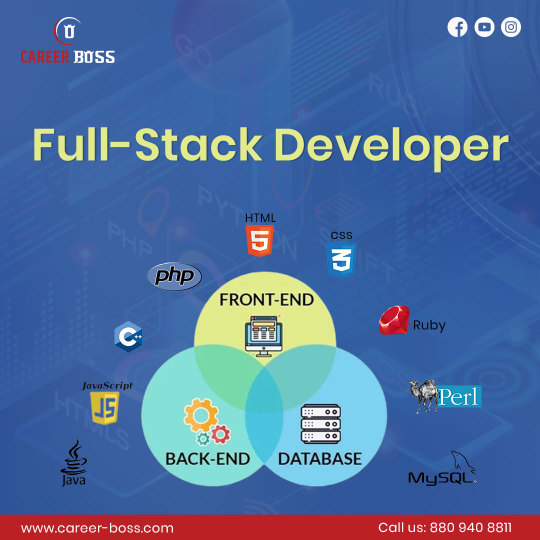#Full stack development course
Explore tagged Tumblr posts
Text
#What is Full Stack#What is Frontend Development#Front End Development Skills#What is Backend Development#Backend Development Skills#Who is a Full-Stack Developer#Salary of Full Stack Developer#Full Stack Development Course
1 note
·
View note
Text
The Essential Tools Every MERN/MEAN + AI Developer Should Know
As web development evolves, the need for full-stack developers with expertise in MERN (MongoDB, Express.js, React, Node.js) and MEAN (MongoDB, Express.js, Angular, Node.js) stacks is growing rapidly. These technologies, combined with Artificial Intelligence (AI), enable developers to build smart, responsive, and data-driven applications. To excel in this domain, developers need to master a set of essential tools that allow them to create robust and scalable AI-powered web applications.
In this blog, we’ll cover the most crucial tools every MERN/MEAN + AI developer should know, categorized into backend, frontend, database, and other development tools. If you’re taking a MERN stack course or a full stack web development course, mastering these tools will make you stand out in the field.
Backend Development Tools
1. Node.js
Node.js is at the core of both MERN and MEAN stacks. It enables developers to execute JavaScript code on the server, allowing full-stack JavaScript development. Its non-blocking architecture makes it perfect for real-time applications and handling large amounts of data. Whether you're enrolled in a full stack development course or a software development course, mastering Node.js will give you the skills necessary to handle high-demand applications.
2. Express.js
If you're pursuing a full stack developer training or taking a MERN stack developer course, you'll encounter Express.js — a fast, minimalist web framework for Node.js. Express simplifies backend development by providing essential features like routing, middleware integration, and easy API creation. This makes it an essential tool for building RESTful APIs and integrating AI features into web applications.
3. Brain.js
For developers integrating AI features like pattern recognition, Brain.js is a valuable library. It's ideal for those enrolled in an Artificial Intelligence Course or exploring AI Courses & Tutorials. Brain.js simplifies the process of building neural networks in JavaScript, allowing developers to integrate AI into their MERN/MEAN projects easily.
4. TensorFlow.js
For more advanced AI implementations, TensorFlow.js is a go-to library. It allows developers to develop, train, and run machine learning models in JavaScript. If you're looking for the best AI courses for beginners, TensorFlow.js is a great tool to get started with. By integrating it into your backend using Node.js, you can run sophisticated AI models for tasks like image recognition or predictive analytics.
Front End Development Tools
5. React
If you're pursuing a MERN stack course, React is the frontend framework you'll need to master. React’s component-based architecture is perfect for building dynamic UIs, and it integrates seamlessly with AI features like real-time data rendering. React’s ecosystem, including tools like Redux for state management and React Hooks for handling state and side effects, makes it an excellent choice for building AI-driven interfaces.
6. Angular
For those enrolled in a MEAN stack program or a full stack web development course, Angular is the go-to framework. Angular's two-way data binding, dependency injection, and RxJS (Reactive Extensions for JavaScript) make it ideal for building single-page applications (SPAs) with real-time AI features such as data-driven visualizations and predictive analytics.
Database Tools
7. MongoDB
A central part of both MERN and MEAN stacks, MongoDB is a NoSQL database designed to store unstructured data. Its flexibility makes it ideal for AI-powered applications that need to manage large datasets, such as user behavior logs or real-time analytics. If you're studying in a MERN stack developer course, MongoDB will be the primary database you'll work with.
8. MySQL
For developers working with structured data, MySQL is a strong choice. This relational database is often used in combination with AI tools like TensorFlow when handling structured data such as user accounts, transactions, and logs.
Other Essential Tools
9. Visual Studio Code (VS Code)
Visual Studio Code is an essential tool for any developer. It offers built-in Git support, a powerful integrated terminal, and a wide array of extensions for JavaScript, Node.js, and AI.
10. AWS (Amazon Web Services)
As cloud computing becomes integral to web development, AWS is a must-know platform. With services like Amazon EC2 for hosting, S3 for storage, and Lambda for serverless computing, AWS provides the infrastructure to scale your applications.
11. Postman
Postman is an API testing tool that simplifies interaction with your backend services. If you're developing APIs to integrate AI features, Postman is indispensable for testing and validating requests.
12. Docker
Docker allows you to containerize your application, ensuring it runs consistently across different environments. It's an essential tool for modern development practices, especially for those pursuing a full stack web developer course.
13. GitHub
Version control is key for any web development project, and GitHub is the industry standard for collaborative development.
14. Kubernetes
Kubernetes is essential for automating the deployment, scaling, and management of containerized applications.
15. Swagger
Swagger is an open-source tool used to document APIs, making it easier to communicate how your backend services work.
Conclusion: Master These Tools with TechEntry
The tools mentioned above form the backbone of modern MERN/MEAN + AI development. Whether you're building dynamic, AI-powered web applications or managing large datasets, mastering these tools is crucial for success in today’s tech landscape.
If you’re ready to dive deeper and learn how to use these tools effectively, TechEntry offers comprehensive courses like the MERN stack development course, full stack web development course, and Artificial Intelligence Course. These courses are designed to help you master the essential tools and techniques to become a skilled MERN/MEAN + AI developer.
Why TechEntry? Hands-on Learning: Gain practical experience through real-world projects. Industry-Standard Tools: Learn the latest tools and technologies such as Node.js, MongoDB, TensorFlow, AWS, and more. Flexible Learning Options: Whether you prefer online or offline learning, we offer both to suit your schedule. Career Support: We offer placement assistance to help you land your dream job as a full stack developer or AI expert.
Take the next step in your career and unlock your potential with TechEntry. Whether you're looking for the best Frontend development course, best backend development course, full stack developer training, or the best AI courses for beginners, our programs are designed to equip you with the skills businesses need today.
#fullstackdevelopercourse#softwaredevelopmentcourse#MERN stack course#Full Stack Course#Full Stack Development Course#MERN/MEAN Full Stack Developer Course#AI Full Stack Engineer!
0 notes
Text
Key Skills You need to become a Java Full Stack Developer in 2025
Do you know what is the most important skill of all time that most people don’t have? Keep in mind that all the top companies in the world are looking for people with this skill. This skill not only contributes to our work but also contributes to real-life situations.

I am talking about problem-solving skills. People with this skill can assess your problems and give you multiple solutions to solve that problem. People with this skill usually play a major role in developing the world through their revolutionary methods and ways of solving complex problems.
Let me ask you this? What do you think companies would prefer?
1. An employee who informs them about problems
Or
2. An employee who solves all their problems
What has all this got to do with full-stack development?
Problem-solving is a skill you can get from diving into the world of Full Stack Development.
Now that you have heard about Full Stack Development, you must be wondering what abilities do you need to become a successful Java full stack developerin 2025. Worry not because Techpaathshala will guide you in your journey towards becoming a top developer.
Read More
#webdevelopment#coding#programming#fullstackdeveloper#developer#software#tech#tech updates#cool tech#full stack development course
0 notes
Text

#Full Stack Development#Full Stack Development Course#Full Stack Development Internship#Full Stack Development Internship in Pune#E3l
0 notes
Text
Master Full Stack Web Development with AI: Transform Your Career with Our Python Full Stack Course
Amid the sea of rapid changes on web development, full stacks remain to make you compete favorably in the technological sphere. How about complementing that with artificial intelligence to set yourself apart even more? Our Full Stack Web Development Course at Oxdu Integrated Media School gives the students a unique platform combining the powers of Python to drive applications based on artificial intelligence. Why full stack development plus AI spells exciting career development for the future.
Why AI Matters in Full Stack Development
AI is transforming the digital landscape across all sectors, from e-commerce to finance and healthcare. Our students learn how to build smarter, faster, and more intuitive applications as they understand how AI works in traditional development. We prepare you through our Full Stack Web Development Course to use AI in many tasks involved in web development, from enhancing user experience to backend processes. This knowledge will give you the immense edge of developing adaptive applications that learn and change for the better with time. What Our AI-Integrated Full Stack Web Development Course Has in Store for You Our Full Stack Web Development Course is all about foundational and advanced skills in both Python and AI. And so, here's the take-home:
Mastering Python for Web Development
Python is one of the most versatile programming languages and is highly favored for full stack web development. For our course, we train students from the beginning starting with Python's core syntax, libraries, and the frameworks required for web development-Flask and Django-which enables them to work easily with AI tools and technologies down the line.
Front-End Development with AI Enhancements
We all know that back-end development is a must-have for any course, but ours also focuses on front-end development to make the entire stack approach complete. They learn HTML, CSS, and JavaScript to create the most interesting user interfaces with those new technologies. Using AI means you will be able to automate some of those processes and integrate tools that can predict UI components to deliver better user engagement and experience.
AI-Powered Back-End Development
Data-driven, intelligent back-end development, using Python and AI is what students learn. The course addresses the ability of AI to automate data handling, make interactions with the database much more efficient, and boost security protocols. You will understand how AI can simplify all those tasks that developers were forced to do manually during the development process and still get faster and more secure applications.
Data Analysis and Machine Learning
One of the most valuable skills in tech today is the ability to analyze data and make informed decisions. In this course, you will learn the basics of machine learning and data science using Python. These skills enable you to design web applications that can learn from data, adapting and improving based on user behavior and data insights.
Project-Based Learning for Real-World Skills
Theory is only a portion of development, as our course focuses on real-world projects that require practical, hands-on development. In the Full Stack Web Development Course, you will work on AI-integrated applications, and by the end of the course, you will have developed several applications that will prove your knowledge in Python, AI, and web development.
Career Opportunities for AI-Integrated Full Stack Developers
Career Options Our graduates from the Full Stack Web Development Course have more than enough choices. With AI-based full stack developers in rising demand daily, organizations are left desperate in the hope of finding the right talent for the following positions: AI-Powered Full Stack Developer Machine Learning Engineer for Web Data-Driven Web Developer Python Developer with AI Specialization These opportunities not only guarantee competitive salary provisions but also offer career growth as AI develops further. Recent hiring trends depict that dev having full stack development and AI knowledge will eventually make up the hard core for e-commerce, finance, and tech startups.
Why Choose Oxdu's AI-Integrated Full Stack Web Development Course?
It's more than just a web development course. Developed by industry experts, the curriculum we offer will ensure you receive relevant, job-ready skills. You'll be guided by professionals in the field to ensure that you have real insights and feedback. Being at the cutting edge of innovation, Oxdu will make you develop applications which harness the power of AI to enhance user experience, automate processes, and deliver data-driven insights.
Conclusion
This is not a trend: It is the future, in terms of AI coming into full stack web development. Placing students on this high-value technology bandwagon with an opportunity in Oxdu will be the kind of offering that goes way beyond simple foundations based on Python and general skillsets for full-stack functionality but provides one with the kind of skills required to implement AI-related developments, thereby making one very valuable to the world of fast advancing technologies. Join Oxdu and transform your career with AI-enhanced full-stack web development!
0 notes
Text
Software Development Training Institute In Bangalore
Techaedu best software training institute in Bangalore offering online & classroom training courses on software development, Python, ML, AI, Digital Marketing, Full Stack Developer, React Native etc. Visite Websitehttps://www.techaedu.com/ Mobile number: 8867 746 186



#Software development training#Full stack development course#UI/UX design training#React Native development#Digital marketing certification
0 notes
Text
Full Stack Developer Roadmap
Introduction to Full Stack Development

The front end is what people see and interact with in their web browser. It includes things like the layout, design, and functionality of the website.
The back end is like the engine behind the scenes. It's where data is stored, processed, and managed. It includes the server, database, and application logic that make everything work smoothly.
So, being a full stack developer means you can handle both the visible parts of a website and the behind-the-scenes stuff. It's like being a jack-of-all-trades in web development!
Understanding the Role of a Full Stack Developer
On the front end, they work with things like HTML, CSS, and JavaScript to create the look and feel of a website. They make sure everything is user-friendly and works smoothly.
On the back end, they deal with databases, servers, and programming languages like Python, Ruby, or JavaScript (using frameworks like Node.js). They manage data, handle user authentication, and make sure the website runs smoothly behind the scenes.
In simple terms, a full stack developer is like a one-stop shop for building and maintaining websites or web applications. They can handle everything from designing how it looks to making sure it works correctly.
Importance of Full Stack Development in Today's Tech Landscape
Full stack development is important because it gives you a big-picture view of how websites and apps work. This means you can understand how different parts fit together and how changes in one area might affect others.
Companies love full stack developers because they can save time and money by having one person who can handle multiple tasks. Whether it's building a new feature, fixing a bug, or optimizing performance, a full stack developer can do it all without needing to rely on others as much.
Plus, in today's fast-paced tech world, things change quickly. Being a full stack developer means you're versatile and can adapt to new technologies and trends easily. This makes you a valuable asset to any team or project.
Front-End Development Essentials
Front-end development is all about making websites or apps look good and work well for users. It's like the part of a house you see and interact with, like the walls, doors, and windows.
To do front-end development, you need to know languages like HTML, CSS, and JavaScript. HTML is like the skeleton of a webpage, CSS is like the paint and decoration that makes it look nice, and JavaScript is like the magic that adds interactivity and functionality.
Basically, front-end development is about creating a great user experience by designing and building the visible parts of a website or app.
Mastering HTML, CSS, and JavaScript is like becoming a wizard of web development.
Mastering HTML, CSS, and JavaScript
HTML is the foundation, like building blocks, for creating the structure of a webpage. It tells the browser what content goes where, like headings, paragraphs, and images.
CSS is the artist's palette. It's what you use to style and make your webpage look awesome. You can change colors, fonts, layout, and more to create the perfect design.
JavaScript is the magic wand. It adds interactivity and functionality to your webpage. With JavaScript, you can make things move, react to user actions, and even fetch data from the internet.
By mastering these three languages, you become a web development wizard, able to create amazing websites and apps that look great and work smoothly!
Exploring Modern Front-End Frameworks (React, Angular, Vue.js)
React is like a LEGO set. It lets you break down your app into reusable components, making it easy to build complex interfaces. It's super popular and used by companies like Facebook and Instagram.
Angular is like a Swiss Army knife. It's a comprehensive framework that comes with everything you need to build a sophisticated web app, including built-in tools for routing, forms, and HTTP requests. It's maintained by Google and used in a lot of big projects.
Vue.js is like a paintbrush. It's lightweight and easy to learn, making it great for smaller projects or for developers who are just getting started. It's known for its simplicity and flexibility, and it's gaining popularity fast.
Each framework has its own strengths and weaknesses, so it's important to choose the right one for your project. But no matter which one you pick, they all make front-end development faster, easier, and more enjoyable!
Back-End Development Fundamentals
back-end development, you work with things like servers, databases, and programming languages like Python, Ruby, or JavaScript (using frameworks like Node.js).
Servers are like the brains of the operation. They handle requests from users, process data, and send back responses. Databases are like the storage room. They store all the information the app needs, like user accounts, posts, or products.
Programming languages are the tools you use to build the back end. They let you write code that tells the server how to handle requests and interact with the database.
Back-end development is all about making sure everything works correctly, securely, and efficiently, so users have a great experience with the website or app.
Learning Server-Side Programming Languages (Node.js, Python, Ruby)
Node.js is like learning a versatile language. It's based on JavaScript, which many people already know for front-end web development. With Node.js, you can use the same language for both front-end and back-end development, making it convenient.
Python is like learning a friendly language. It's known for its simplicity and readability, making it great for beginners. Python is widely used in web development, data science, and many other fields.
Ruby is like learning an elegant language. It's known for its clean syntax and developer-friendly features. Ruby on Rails, a popular web framework built with Ruby, makes web development faster and easier.
Each language has its own strengths and specialties, so it's worth exploring to see which one you like best. But no matter which one you choose, learning a server-side programming language opens up a world of possibilities for building powerful and dynamic websites and apps.
Database Management Systems (SQL and NoSQL)
SQL databases are like well-structured filing cabinets. They use a language called SQL to organize data into tables with rows and columns. SQL databases are great for handling structured data, like user information, product catalogs, and financial records.
NoSQL databases are like flexible storage containers. They can handle different types of data, including unstructured and semi-structured data, like documents, JSON files, and multimedia files. NoSQL databases are good for handling large volumes of data and for applications that need to scale quickly.
Both SQL and NoSQL databases have their own strengths and are suited for different types of projects. SQL databases are often used for traditional relational data, while NoSQL databases are used for more complex or dynamic data structures.
Diving into Full Stack Frameworks

Django is like a complete toolkit. It's built with Python and comes with a lot of features right out of the box, like user authentication, database management, and URL routing. Django is great for building large and complex web applications.
Flask is like a minimalist toolkit. It's also built with Python, but it's more lightweight and flexible compared to Django. Flask gives developers more freedom to choose the tools and libraries they want to use, making it great for smaller projects or for developers who prefer simplicity.
Express.js is like a speed demon toolkit. It's a lightweight framework for building web applications with JavaScript on the server side. Express.js is known for its speed and simplicity, making it a popular choice for building fast and scalable web servers.
Each framework has its own strengths and specialties, so it's worth exploring to see which one fits your project and preferences best. But no matter which one you choose, full stack frameworks can save you time and effort by providing built-in tools and conventions for building web applications.
Integrating Front-End and Back-End Technologies
The front end, which users see and interact with, is built using languages like HTML, CSS, and JavaScript. It's like the face of the website or app.
The back end, on the other hand, handles the behind-the-scenes stuff like storing data, processing requests, and managing users. It's built using server-side languages like Python, Ruby, or JavaScript (with frameworks like Node.js), along with databases like SQL or NoSQL.
To integrate the front end with the back end, developers use methods like API calls. APIs (Application Programming Interfaces) act as bridges between the front end and back end, allowing them to communicate and share data seamlessly.
So, integrating front-end and back-end technologies is all about making sure they work together smoothly to create a cohesive and functional website or app for users to enjoy.
Version Control and Collaboration Tools
Version control helps keep track of changes made to code over time. It's like having a time machine for your project, where you can go back to previous versions if something goes wrong. Git is a popular version control system that many developers use.
Collaboration tools make it easier for team members to work together on coding projects. They provide features like shared repositories, issue tracking, and code review, making it easier to collaborate and communicate effectively.
By using version control and collaboration tools, developers can work together more efficiently, avoid conflicts, and keep track of changes, leading to smoother and more organized coding projects.
Git and GitHub for Version Control
Git is a tool that tracks changes you make to your code over time. It helps you save different versions of your work, so you can go back to an earlier version if needed. It's like having a backup system for your code.
GitHub is like a social network for developers. It's a platform where you can store your Git repositories (collections of code), share them with others, and collaborate on projects together. It's like a hub where developers can work together, share ideas, and improve each other's code.
Together, Git and GitHub make it easy for developers to work on projects together, keep track of changes, and share their work with the world. It's a powerful combination that has revolutionised the way developers collaborate and build software.
Collaboration Tools for Team Projects
These tools provide features like shared file storage, task management, and communication channels. For example, Slack is a popular tool for real-time messaging and file sharing, while Trello is great for organizing tasks on a digital board.
By using collaboration tools, team members can stay organized, communicate effectively, and work together smoothly, even if they're not physically together. It's like having a virtual office where everyone can collaborate and get things done.
Building RESTful APIs
API stands for Application Programming Interface. It's like a menu that tells other programs or services how they can interact with yours.
RESTful means following a set of rules called REST (Representational State Transfer). It's like a standard recipe that ensures your API is easy to understand and use.
So, building a RESTful API involves designing a set of rules and endpoints that other programs can use to request and receive data from your application, just like ordering food from a menu in a restaurant.
Understanding REST Architecture
REST stands for Representational State Transfer. It's a set of guidelines that developers follow to create web services that are easy to understand, use, and scale.
In simple terms, REST architecture organizes web services into resources, each identified by a unique URL. You can perform actions on these resources using standard HTTP methods like GET, POST, PUT, and DELETE.
Imagine each resource as a page in a book, and the HTTP methods as actions you can take, like reading a page, adding a new page, updating a page, or removing a page.
By following REST principles, developers create APIs that are intuitive, consistent, and compatible with a wide range of platforms and technologies. It's like having a common language for building web services that everyone can understand.
Developing RESTful APIs with Express.js
Express.js is a framework for Node.js, which is a platform for building web applications. With Express.js, you can create routes for different endpoints (like URLs) in your application.
So, developing RESTful APIs with Express.js involves setting up these routes to handle different types of requests (like GET, POST, PUT, DELETE) from clients (like web browsers or mobile apps).
Think of it like creating a system where clients can send requests to your server, and your server knows how to handle those requests and send back the appropriate responses. It's like having a courier service that knows exactly where to pick up and drop off packages.
Authentication and Authorization
Authentication is proving who you are, like showing your ID. You might use a password, fingerprint, or phone code.
Authorization is what you're allowed to do after proving your identity. It's like different levels of access in a building. For instance, employees have access to some areas, while managers have access to more.
So, authentication makes sure only the right people can get in, and authorization decides what they can do once inside. They work together to keep your accounts safe.
Implementing User Authentication and Authorization
Authentication is checking IDs to verify users' identities, like providing a username and password.
Authorization is assigning different access levels, like VIP or regular, once users are verified.
Together, they control who gets in and what they can do.
Security Best Practices
Use strong passwords: They're like sturdy locks for your accounts.
Keep software updated: It's like fixing holes in your fence to keep hackers out.
Be cautious with links and attachments: Opening them can let malware in, like letting strangers into your home.
Enable two-factor authentication: It adds an extra lock to your accounts.
Back up your data: It's like keeping spare keys safe in case of emergencies.
Security Best Practices
Strong Passwords: Mix letters, numbers, and symbols for security.
Regular Updates: Keep software current to plug security holes.
Online Caution: Avoid suspicious links and downloads.
Two-Factor Authentication: Add an extra security step.
Data Backup: Save important files regularly for safety.
Front-End Framework Deep Dive
Front-end frameworks simplify web development:
React: It's like LEGO for building interfaces.
Angular: Think of it as a Swiss Army knife for large-scale apps.
Vue.js: It's like a paintbrush, offering flexibility and simplicity.
Mastering these frameworks empowers developers to create efficient, user-friendly web applications, much like mastering tools in a toolbox for building amazing things!
Advanced Techniques in React/Angular/Vue.js
React: Mastering state management with Redux or Context API.
Angular: Using Angular Universal for server-side rendering.
Vue.js: Leveraging Vuex for centralized state management.
These are advanced techniques that can enhance the functionality and performance of your web applications built with React, Angular, or Vue.js.
State Management and Performance Optimization
State Management: Keeping track of the current condition or data in your app.
Performance Optimization: Making your app run faster and smoother.
Working with Databases
Working with databases is like managing a collection of organized files on your computer. You store and retrieve information from these files using a language called SQL. It's like sorting through folders and files to find what you need.
SQL vs. NoSQL: Choosing the Right Database
SQL databases are like well-organized filing cabinets where data is stored in tables with rows and columns, good for structured data like user information.
NoSQL databases are like flexible storage containers where data can be stored in various formats, good for unstructured or semi-structured data like social media posts or product catalogs.
Choose SQL for structured data that needs a clear organization, and NoSQL for flexibility with unstructured or rapidly changing data.
CRUD Operations and Database Design
CRUD operations are like the basic actions you can do with data in a database: Create, Read, Update, and Delete.
Database design is like creating a blueprint for how your data will be organized and structured in the database, making it easy to perform CRUD operations efficiently.
Deployment and Hosting
Deployment is the process of preparing your website or app for the internet. It involves things like configuring servers, setting up databases, and optimizing code.
Hosting is like renting space on a server to store your website or app files. Hosting providers offer services that make it easy to upload and manage your files so they're accessible to visitors on the internet.
So, deployment and hosting work together to make your website or app available to the world wide web.
Deploying Applications to Cloud Platforms (AWS, Heroku, Firebase)
AWS: It's like renting a big store in a mall, offering a wide range of services.
Heroku: Think of it as a specialized boutique, known for simplicity and ease of use.
Firebase: It's like setting up a pop-up shop, focusing on real-time data syncing.
Each platform has its strengths, so explore to find what fits your project best. Deploying on a cloud platform makes your app accessible worldwide.
Continuous Integration and Continuous Deployment (CI/CD)
CI/CD streamlines development:
Continuous Integration: It's like assembling puzzle pieces as they're created, with automated tests ensuring smooth integration.
Continuous Deployment: Think of it as putting the finished product on the market right away after passing tests.
CI/CD helps catch bugs early and deliver updates quickly, ensuring high-quality software reaches users fast.
In conclusion, Becoming a full stack developer is like embarking on an adventure. You start by learning front-end basics like HTML, CSS, and JavaScript, then dive into back-end technologies like Node.js or Python. Along the way, you master frameworks, version control, and deployment. With these skills, you're equipped to build complete web applications from scratch, contributing to the dynamic world of technology.mn
#Full Stack Development#Front End Development#Back End Development#Web Development#CSS#html5#nodejs#python#c++ programming#Full Stack Development Course
1 note
·
View note
Text
Exploring Full Stack: Mastering the Java Learning Platform for a Rewarding Career

The rapid advances in software and technology development have created an unprecedented demand for skilled individuals in this field. The trend is only expected to increase as the industry evolves. In such a demanding market, seizing the opportunity to become part of this rewarding industry would be of great importance. But how?
Well! You have the option to join a Full-stack development course or get a pro in the Java learning platform. If you are from an IT background, you must have a settled idea about these platforms already. Here is more on these courses to enable you to prepare well for your professional career ahead. Let’s start by getting a deeper insight into the Full Stack development course.
What Is A Full Stack Development Course?
This specific course covers the skills and technologies required to develop the client-side and back-end server side of web applications. It consists of HTML, CSS, and JavaScript. Besides, you may also learn Node.js, Python, Ruby on Rails, or Java, depending on your capabilities and grasping power.
A Full-stack development course also includes programming languages such as SQL or No SQL, version control systems (like Git), and frameworks. If you proceed further, you may have to learn topics like API development, deployment, and testing.
The course is wide, and it is important to research well before getting on it. The need is to understand your goals and the specific technology in which you want to build your career. It will help to boost your future in the IT sector even further.
When looking to enter the field of full-stack development, you must ensure the authenticity of the course. Renowned institutes offer study programs developed by only industry experts. This provides hands-on learning and a deep understanding of technologies.
After the course, you need to gear up for the challenges and opportunities ahead. The innovative and tech-first approach, combined with affordability, ensures that you receive the highest quality education. To ensure a specialised learning experience on Full Stack, you must learn Java Full Stack.
Full Stack Development Course: Enhancing Your Job Prospects
Java Full Stack is a specialised platform for developing dynamic web applications. This Java learning platform helps you acquire essential industry skills like React, Angular, Spring Boot, hibernate, and JSP. These highly skilled web services are instrumental in developing interactive and useful web applications.
Java is a versatile programming language used for both front-end and back-end development. It helps you build an entire web application and adds to your programming skills if you wish to stay relevant to the tech industry. By learning Java, you can increase your job prospects and career opportunities as well. Therefore, to raise your bar in the IT sector, it would be wise to join a full-stack development course today.
Summary: By joining the Full Stack development course, you can expose yourself to a new world of opportunities. Specifically, the opportunity to gain practical knowledge about the Java learning platform will equip you with the skills needed to build powerful and innovative web applications.
0 notes
Text

Full Stack Developer Training Program with Placement Assurance
If coding is your superpower, you're destined for a shining future with Dice Academy premier full-stack developer course in Delhi NCR. Our industry-oriented curriculum is meticulously designed to equip you with the skills and knowledge demanded by the tech industry. In the dynamic realm of full-stack development, a solid foundation in fundamentals and philosophy is as crucial as proficiency in tools. Our comprehensive full-stack development course with placement assurance ensures you cover all aspects to enhance your prospects of a successful career. From front-end and back-end development to databases and frameworks, prepare to immerse yourself in the world of coding and web development. Unlock boundless opportunities with our training program and pave the way for a rewarding career in full-stack development.
0 notes
Text

0 notes
Text
A commonly used stack for developing dynamic web apps is known as MEAN Stack Development. MEAN is an abbreviation that means MongoDB, Express.js, Angular.js, and Node.js. MongoDB, a NoSQL document-oriented database, Express.js, a web application framework, Angular.js, a front-end JavaScript framework, and Node.js, a server-side JavaScript runtime environment. MEAN Stand is a free stack of full technologies based on Java script designed for creating fast, safe, and expandable web apps. It is light in weight and allows developers to easily build sophisticated applications with a combination of diverse technologies. It helps in creating single-page apps, real-time apps, mobile applications, etc. MEAN stack development involves the use of fast and convenient ways to develop web applications.
The full-stack approach can create many new businesses compared to anything hitherto. Businesses can create their bespoke software or applications that is built based on multiple technologies and various types of frameworks. Using a stack approach, firms develop personalized solutions that place the business ahead of the competition. Furthermore, they will be able to scale up their applications rapidly without necessarily investing in any additional hardware or software. Full-stack development is also a cost-effective practice where organizations can leverage existing resources for optimal effect. Full-stack development is indispensable for the creation of new products and services, expansion of customer base, and increasing market share for business. The advantage of full-stack development is that it provides more business opportunities than ever before.

#full stack development blog#Full stack development skills#Full stack development salary#full stack development course#full stack development roadmap#full stack development - wikipedia#full stack development syllabus
0 notes
Text
What is the Best Fullstack Development Course for Beginners?

Embarking on an exploration into the realm of coding can evoke a mix of excitement and a sense of being daunted. With an array of courses and institutes to choose from, finding the right path is crucial. The Career Boss Institute stands out with its comprehensive Fullstack and HTML Development Courses for aspiring developers in Bhojpur and Ara. This blog post aims to guide beginners through the maze of options and highlight why the Career Boss Institute is your go-to destination for mastering full-stack development.
Reasons to Opt for Full-Stack Development
Fullstack development is the Swiss Army knife of the coding world. It equips you with a versatile set of skills, covering both front-end and back-end technologies. This holistic approach not only makes you a well-rounded developer but also significantly boosts your employability in today’s dynamic tech landscape.
The Career Boss Institute Advantage:
Nestled in the heart of Bhojpur, the Career Boss Institute has emerged as a beacon of excellence in tech education. Their Best Fullstack Development Course in Bhojpur is tailor-made for beginners, ensuring a smooth transition from novice to pro.
Comprehensive Curriculum: The course covers essential technologies such as HTML, CSS, JavaScript and more advanced back-end technologies, ensuring a well-rounded skill set.
Hands-On Learning: Students get to work on real-world projects, solidifying their learning and building a robust portfolio with a strong emphasis on practical experience.
Industry Expert Instructors: Learn from the best. The instructors at Career Boss Institute are seasoned professionals with real-world tech industry experience.
Career Support: The institute offers career counseling and placement assistance to help you navigate the job market with confidence.
Deep Dive into HTML Development:
Understanding HTML is the cornerstone of web development. The Best HTML Development Course in Ara by Career Boss Institute is specifically designed for beginners. This course lays a strong foundation, teaching you how to structure web pages effectively and creatively.
Course Highlights:
Learn the basics of HTML5 and its applications.
Practical sessions on building and styling web pages.
An introduction to integrating HTML with CSS and JavaScript.
Why Fullstack Development is a Smart Choice for Beginners:
As a beginner, you might wonder why to start with fullstack development.
Versatility: Fullstack development skills open doors to various roles in the tech industry, from web development to software engineering.
Better Understanding of Web Architecture: You gain a holistic understanding of how web applications work by learning both front-end and back-end.
Increased Job Opportunities: Fullstack developers are in high demand and this trend is only growing.
The Learning Path at Career Boss Institute:
Starting with the Basics: The journey at Career Boss Institute begins with the fundamentals. Their courses are designed to build your knowledge from the ground up even if you are new to programming.
Progressive Learning: The curriculum is structured to gradually increase in complexity. You start with front-end technologies like HTML and CSS, then move to JavaScript and eventually delve into back-end programming.
Project-Based Approach: You will work on various projects to solidify your learning. This practical experience is invaluable and makes the theoretical knowledge gained in the classroom come alive.
Mentorship and Support: You are not alone throughout your learning journey. The institute provides mentorship from experienced developers who guide you through challenging concepts and coding hurdles.
Student Success Stories:
Career Boss Institute is proud of its former students. Originating from Bhojpur and Ara with no prior coding experience, these individuals have achieved remarkable success in the technology sector. Their accomplishments serve as a powerful endorsement of our teaching approach and course content.
How to Enroll:
Enrolling in the Best Fullstack Development Course in Bhojpur or the Best HTML Development Course in Ara is straightforward. Visit the Career Boss Institute website, fill out the application form and our admissions team will guide you through the process.
Conclusion
Choosing the right course is a crucial step in your tech career. The Best Fullstack Development Course in Bhojpur and the Best HTML Development Course in Ara at Career Boss Institute are designed to give you a strong foundation and a clear path to success in the tech industry. You are well on your way to becoming a skilled full-stack developer with our expert instructors, hands-on learning approach and comprehensive curriculum.
#Best HTML Development Course in Ara#full stack development course#career boss#html development course
0 notes
Text
Within the realm of full-stack development, building inclusive applications is a collaborative effort. Each contributor, whether a front-end designer or a back-end engineer, plays a crucial role in moulding a digital environment that is welcoming and accessible to a diverse user base. By embracing the principles of web accessibility and integrating them into a thorough full-stack development curriculum, we can actively play a part in creating a digital space that is equitable and accessible for everyone.
0 notes
Text
#Full Stack Development#Full Stack Development Course#Full Stack Development internship#Front End Development#Back End Development#E3l
0 notes
Text
Join Full Stack Development Training at Appwars Technologies
Begin on a learning journey with our Full Stack Development Training, designed for beginners and tech enthusiasts. Acquire essential skills in web development effortlessly. Join Appwars Technologies for an immersive and supportive learning experience, and kickstart your career in tech today.
For more : https://appwarstechnologies.com/full-stack-development-training-in-noida/
Address: B – 3, Sector – 2, Noida, U.P. – 201301
Contact Us: 8743019452
Full Stack Development Course
Full Stack Development Training
0 notes